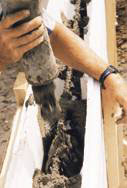- Concrete Pumps Home
- Buyer's guide to concrete trailer pumps: Questions to ask before you buy
- Removing blockages: Possible causes, locating and clearing blockages
- Safety Considerations: Pump maintenance, truck positioning and hose selection
- Pumping tips for insulating concrete forms (ICFs)
- Related Information:
- Pumping equipment and materials for slabjacking
- Concrete Admixtures
Section Sponsor

Packaged Admixtures
Quick Concrete Pumping Tips For Insulating Concrete Forms (ICFs)

ICFs, one of the hottest trends in concrete construction today, are hollow blocks or panels made of rigid polystyrene foam erected and filled with concrete to produce insulated walls. Since concrete must be placed into ICFs at a more controlled rate than on standard pours, great care must be taken in selecting the proper materials, equipment, and pour procedures.
Pre-pour ChecklistA thorough pre-pour inspection should be conducted, especially if your company didn't do the initial assembly. Here are some problem points to check for:
- Check all measurements, including footprint, wall openings, lintels. Check for level, plumb and square walls and openings.
- Ensure that all reinforcing steel has been properly placed and inspected by the local building department, if required by local codes.
- Make sure that all sleeves, fasteners, braces for the formwork and provisions for attaching floor decks are in place.
- Check form system for irregularities, including damaged forms, gaps, weak spots and irregular joints.
The MixRule of thumb: Use concrete with a 4- to 6-inch slump, made with 3/8-inch maximum-size course aggregate (pea-rock or -inch minus aggregate).
Remember that this size aggregate requires a higher sand content, a greater amount of water, and therefore an increased cement content in order to achieve a 6-inch slump with the necessary strength, so order the mix accordingly.
The EquipmentPolystyrene foam forms are less tolerant to concrete pressures than wood or aluminum forms, which means a 2-inch diameter hose is the ideal size for placement. This lets the line pump run at full speed without danger of a form blowout.
In addition, the smaller diameter slows the flow of concrete, giving the hose operator better control of the placement. Reducers may be used on a boom pump to bring the diameter down to 2 or 3 inches, and 90-degree elbow fittings attached at the end of the hose assembly creates an "S" in the line, breaking the long fall of the concrete.
The CureICFs insulate fresh concrete, which means the material cures properly even in extreme weather conditions. However, if the temperature at the job site is going to fall below freezing within a couple of days after the pour, blankets should be put along the exposed top of the wall for insulation.
If the weather is very hot and dry, use plastic sheeting over the exposed top in order to prevent excessively rapid drying of the concrete.
Do not proceed with an ICF pour during a heavy rain. If there is standing water in the form cavities, drain the cavities prior to placing the concrete.
The Placement and Pour PatternMost ICF manufacturers provide the proper pour pattern to use with their products. However, here are some rules of thumb:
Start the pour placement under windowsills up to 3 feet, or the bottom of the sill. Then, starting at a corner, place the concrete around the wall perimeter in 3-foot lifts between the windows.
Using hammers to tap 2X4 blocks placed flat against the wall, agitate the formwork on the ground, or the floor beneath the pour. While some ICF manufacturers recommend the use of immersion vibrators, others prohibit them because they can damage the forms. Always check with the manufacturer prior to any use of these devices.
Blowout PreventionBlowouts in ICFs are rare, but here are some tips on reducing the risk of such an occurrence:
Have a worker continuously tap the formwork during concrete placement to check for any voids. If a hollow sound in an otherwise solid wall is detected, dislodge the clog and fill the void by slipping a long piece of strapping or rebar into the concrete from above, and slide it up and down above the void.
A bulge in the formwork is a warning sign of a possible blowout. In this case, the placing crew should be signaled to move the pour away from the problem area. The bulge can then be braced with a 2X2-foot square of plywood wedged to the wall with a wooden kicker.
In case of a blowout, the torn foam must be cut away, and the concrete scooped out to a level below the blowout. Then, replace the foam and set a square of plywood against the wall, front and back, to cover the damaged area.




